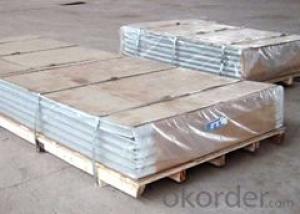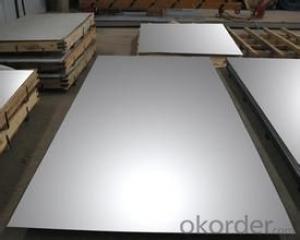Aluminum sheet,plate for construction use
- Loading Port:
- China Main Port
- Payment Terms:
- TT OR LC
- Min Order Qty:
- -
- Supply Capability:
- -
OKorder Service Pledge
OKorder Financial Service
You Might Also Like
Aluminium is a relatively soft, durable, lightweight, ductileand malleablemetalwith appearance ranging from silvery to dull gray, depending on the surfaceroughness. It is nonmagnetic and does not easily ignite. A fresh film ofaluminium serves as a good reflector (approximately 92%) of visible lightand an excellent reflector (as much as 98%) of medium and far infraredradiation. The yield strength of pure aluminium is 7–11 MPa,while aluminium alloys have yield strengths ranging from200 MPa to 600 MPa. Aluminium has about one-third the densityand stiffness of steel. It is easily machined,cast, drawn and extruded.
Aluminium alloys (or aluminum alloys; see spellingdifferences) are alloysin which aluminium(Al) is the predominant metal. The typical alloying elements are copper, magnesium,manganese,silicon,tin and zinc. There are twoprincipal classifications, namely casting alloys and wrought alloys, both of which are furthersubdivided into the categories heat-treatableand non-heat-treatable. About 85% of aluminium is used for wrought products,for example rolled plate, foils and extrusions.Cast aluminium alloys yield cost-effective products due to the low meltingpoint, although they generally have lower tensile strengthsthan wrought alloys. The most important cast aluminium alloy system is Al–Si,where the high levels of silicon (4.0–13%) contribute to give good castingcharacteristics. Aluminium alloys are widely used in engineering structures andcomponents where light weight or corrosion resistance is required
Specification:
Alloy: AA1050, 1060, 1100,AA3003, 3005, 3015, 5052, 5754, 5083,8011, etc
Temper:H14/16/18/22/24/32, HO etc.
Thickness:0.2mm—100mm
Width: 100mm—2300mm (Can be slitted)
Application: Roofing, Can stock, Marine plate,Anti-slipery purpose in vehicles, packing and appliance.
Features:
1. Excellent quality of products
2. Quick delivery
3. Best service to clients
4. BV,SGS avalible
5. No buckle o waveness
6. Tension leveling
7. Certificate of Origin
8. Form A,E
Packaging Detail:
Carton ,Woodenpallet with plastic protection packing ,standard seaworthy packing or as yourrequest.
ProductionCapacity:
AnnualProduction capacity of 600,000 tons.
Products areexported to United States, Canada, U.A.E, Brazil, Mexico,Thailand, Vietnam,Nigeria etc, over 100 countries andregions all over the world.
Production Line:
CNBM aluminumproduction base is comprised of 18 aluminumannealers, 10 coil and foilmills, 4 continuous production lines, 2hot rolling production line and 3prepainted lines.
FAQ:
1. What is the form of payment?
Normally 30% TT, L/C
2. Type of quotation?
FOB, CFR, CIF
3. Port of loading?
Shanghai port
4. Delivery time?
30 day after client’s deposit
- Q:Are aluminum sheets suitable for HVAC applications?
- Yes, aluminum sheets are suitable for HVAC (Heating, Ventilation, and Air Conditioning) applications. Aluminum is a popular material choice for HVAC systems due to its various beneficial properties. Firstly, aluminum is lightweight, which makes it easier to handle and install in HVAC systems. This is particularly important for large systems that require a significant amount of material. Secondly, aluminum is highly resistant to corrosion, making it ideal for use in HVAC applications where exposure to moisture and condensation is common. This resistance to corrosion ensures the longevity and durability of the HVAC system, reducing maintenance and replacement costs in the long run. Additionally, aluminum has excellent thermal conductivity, allowing it to efficiently transfer heat or cold air throughout the HVAC system. This property helps to ensure efficient heating and cooling, reducing energy consumption and resulting in cost savings for the user. Furthermore, aluminum sheets can be easily formed and shaped to fit specific HVAC requirements, allowing for customized designs and precise installation. This versatility makes aluminum a preferred choice for ductwork, heat exchangers, and other components in HVAC systems. Overall, aluminum sheets are well-suited for HVAC applications due to their lightweight, corrosion resistance, thermal conductivity, and flexibility. These properties contribute to the efficiency, durability, and performance of HVAC systems, making aluminum a preferred material in the industry.
- Q:What's the maximum size of 3 mm thick aluminum sheet?
- See tolerance taggingIf there is no tolerance, see the accuracy level of the workpiece and check the tolerance listA 3-4 mm deviation is acceptable if the magnitude is not noted and is of no importanceThat is, the 3.5mm is OK, if the lower accuracy is generally 2.95
- Q:What are the typical uses or applications for 101 aluminum sheets?
- 101 aluminum sheets are commonly used in a variety of applications such as roofing, siding, gutters, and general construction due to their excellent corrosion resistance, high formability, and durability. They are also utilized in the automotive industry for body panels, trims, and interior components. Additionally, 101 aluminum sheets are often used for packaging, electrical enclosures, and kitchen equipment due to their lightweight nature and ability to withstand various environmental conditions.
- Q:How do aluminum sheets perform in terms of thermal expansion and contraction?
- Aluminum sheets have a relatively high coefficient of thermal expansion, meaning they expand more than other materials when heated and contract more when cooled.
- Q:aluminum is used to make planes, cast iron is used to make heavy mashines. what is the comparisonof teh densities of aluminum and cast iron?
- The density of aluminum is MUCH lower than cast iron (thus, aluminum is LIGHTER). Because it is lighter, it would be much more ideal for applications like plane building, which is why aluminum is used over cast iron in airplanes. As well, aluminum has a protective coating called aluminum oxide which protects it from corroding in water. [Answer: see above]
- Q:What are the different surface finishes available for aluminum sheet?
- There are several surface finishes available for aluminum sheet, including mill finish, brushed finish, anodized finish, and painted finish.
- Q:Can aluminum sheet be used for medical applications?
- Certain medical applications can utilize aluminum sheet. This material is lightweight, durable, and resistant to corrosion, making it suitable for a range of medical devices and equipment. Prosthetic limbs, braces, and orthopedic implants can be manufactured using aluminum sheets. Additionally, medical instruments like surgical trays, sterilization containers, and imaging equipment can be produced using aluminum. However, it is important to consider that not all medical applications can use aluminum, as some devices may require specific properties or materials to meet regulatory standards and ensure patient safety. Therefore, the use of aluminum sheet in medical applications should be assessed on a case-by-case basis, taking into account the specific requirements and regulations of each application.
- Q:5052 can aluminum plate be machined with laser cutting machine?
- Can cut, but the incision does have cut marks, if processing 3 mm below the thickness, incision quality will be better.
- Q:What are the different methods of surface cleaning aluminum sheets?
- Depending on the amount of dirt or contamination, there are various ways to clean aluminum sheets. The following methods are commonly employed: 1. Mechanical Cleaning: This method entails physically scrubbing the aluminum sheet using brushes, abrasive pads, or sandpaper. It effectively removes light dirt, grease, or oxidation. However, caution must be exercised to prevent scratching or damaging the surface. 2. Chemical Cleaning: To eliminate dirt, stains, or oxidation, specific cleaning agents or solutions are employed. Alkaline cleaners, acidic cleaners, and solvents are frequently used. It is crucial to adhere to the manufacturer's instructions and take necessary safety precautions when handling chemicals. 3. Pressure Washing: High-pressure water jets are used to eliminate dirt, grime, and other contaminants from the aluminum sheet's surface. This method is quick and efficient, especially for large or heavily soiled surfaces. However, care should be taken to avoid excessive pressure that could dent or damage the aluminum. 4. Electrolytic Cleaning: An electrolyte solution and an electric current are utilized in this method to remove corrosion, oxidation, or tarnish from the aluminum sheet. The sheet is submerged in the electrolyte bath, and the electric current helps dissolve the contaminants. This method is particularly effective for heavily oxidized or tarnished surfaces. 5. Chemical Etching: Chemical etching is a process that selectively removes the surface layer of the aluminum sheet using a combination of chemicals. It is commonly employed to eliminate anodized coatings or to create decorative patterns. However, this method necessitates specialized equipment and expertise. It is important to consider the specific requirements of the aluminum sheet, the level of contamination, and the desired outcome when choosing a cleaning method. Consulting the manufacturer's guidelines or seeking professional advice is always recommended to ensure the most suitable and safe cleaning method is employed.
- Q:Can aluminum sheets be an alternative to glass in certain applications?
- Yes, aluminum sheets can be an alternative to glass in certain applications. Aluminum sheets offer several advantages over glass, making them a suitable choice in specific scenarios. Firstly, aluminum sheets are lightweight and durable, making them ideal for applications where weight is a concern, such as in aerospace or automotive industries. Glass, on the other hand, is relatively heavy and brittle, which can limit its use in certain environments. Additionally, aluminum sheets have excellent corrosion resistance, making them suitable for applications in marine or coastal environments where glass may deteriorate over time due to exposure to saltwater. Aluminum sheets also have a high strength-to-weight ratio, allowing for greater design flexibility and structural integrity compared to glass. Moreover, aluminum sheets can provide better thermal insulation properties compared to glass. They offer improved heat transfer resistance, which can be advantageous in applications where temperature control is crucial, such as in the construction industry. Furthermore, aluminum sheets can be more cost-effective than glass in certain applications. The production and installation costs of aluminum sheets are often lower compared to glass, making them a more economical choice for large-scale projects. However, it is important to note that glass still has its own unique properties and advantages that make it the preferred choice in many applications, such as its transparency and optical clarity. Glass also offers better resistance to scratches and chemical corrosion compared to aluminum sheets. In conclusion, while aluminum sheets can be a viable alternative to glass in certain applications due to their lightweight, durability, corrosion resistance, thermal insulation properties, and cost-effectiveness, the choice between the two materials ultimately depends on the specific requirements and constraints of the application in question.
1. Manufacturer Overview |
|
|---|---|
| Location | |
| Year Established | |
| Annual Output Value | |
| Main Markets | |
| Company Certifications | |
2. Manufacturer Certificates |
|
|---|---|
| a) Certification Name | |
| Range | |
| Reference | |
| Validity Period | |
3. Manufacturer Capability |
|
|---|---|
| a)Trade Capacity | |
| Nearest Port | |
| Export Percentage | |
| No.of Employees in Trade Department | |
| Language Spoken: | |
| b)Factory Information | |
| Factory Size: | |
| No. of Production Lines | |
| Contract Manufacturing | |
| Product Price Range | |
Send your message to us
Aluminum sheet,plate for construction use
- Loading Port:
- China Main Port
- Payment Terms:
- TT OR LC
- Min Order Qty:
- -
- Supply Capability:
- -
OKorder Service Pledge
OKorder Financial Service
Similar products
New products
Hot products
Hot Searches
Related keywords




























